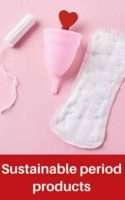The average disposable pad is made from plastic and synthetic fibres. Up to 800 years will pass before this pad decomposes. Once it does, it will leave behind small plastic compounds, meaning that though the pad has disintegrated, it is still very much littering the earth. Even tampons, which look to be made up of only cotton, contain plastics.
A study of UK women found that a single person who menstruates will use an estimated 11 000 to 16 000 pads and tampons in their lifetime. This means that they will dispose of roughly 200 kg of tampons, pads and applicators. Though this statistic may seem overwhelming, reusable menstrual products in the form of pads, menstrual cups, and period panties are gaining popularity and can offer environmentally conscious alternatives to single-use products. As the impact of menstrual product waste on the environment is becoming more widely known, adjustments are also being made to single-use products to make them more sustainable.
Types of Reusable Menstrual Products:
– Reusable Pads and Panties are made of material such as cotton or bamboo and can be washed after use.
–Menstrual Cups are bell-shaped devices with a stem for easy removal. They are made of medical-grade silicone, latex, or thermoplastic isomers that are inserted into the vagina and collect menstrual blood. They can be left in for up to 12 hours and provide a safer option to those with limited access to water and sanitation.
I myself use both period panties and menstrual cups. I initially found the process of inserting and removing the menstrual cup something to get used to, however now that I have got the hang of it, I would not go back. The silicone that the menstrual cup is made from means that insertion is easy and you do not feel it once it is inside. In contrast to the cup, I have found that the material and chemicals that are in tampons leaves my vagina feeling dry and irritable after a cycle.
When I am not using menstrual cups, I switch over to period panties. My initial concern was that they would be more messy than pads, however I have found the opposite to be true. The blood absorbs instantly into the underwear and there are no lingering smells. My period panties can also absorb more blood than the single-use pads I had previously relied on. This means that the environment remains moist-free and feels a lot more comfortable. All I have to do is make sure that I rinse them as soon as I take them off, an easy process.
Benefits of Reusable Menstrual Products:
Saving money
Period panties & menstrual cups can last up to 5 years if looked after well. Though they cost more up front, you can save 5 years worth of money spent on single-use period products. Mr Price currently sells reusable pads from R49.99. They also sell period panties that can be used for up to 2 years at R149.99.
More environmentally friendly.
Though many reusable period products have plastic materials (such as polyester and polyurethane) in their make-up, they are still considered to be more environmentally friendly than single-use products. Menstrual cups have been shown to have the lowest environmental impact of only 1.5% that of disposable products. If possible, look for reusable pads and period panties made from Bamboo fibre (such as these by Blushproof for adults and kids).
Reusable Pads can be handmade from scrap material.
Follow youtube tutorials such as this one to discover how.
Things to look for when buying period products:
Though cheaper reusable period products are becoming more widely available, you may still prefer to buy single-use products. Here are some things to look for that are better for you and the environment.
– Sanitary products that don’t have unnecessary plastic packaging can make a big difference to lessening waste that ends up in landfills. ANNA and NatraCare are both good examples of menstrual products that are reducing plastic in their packaging.
– Period products that are biodegradable and more importantly, compostable due to their composition of only natural materials (such as these by NatraCare), can degrade properly and thus leave nothing (or almost nothing behind).
– Look for organic tampons, sanitary pads, and panty liners. Certified organic cotton takes 91% less water and 72% less energy to produce than conventional cotton (cotton farming that uses genetically modified or chemically treated seeds).
– Look for Unbleached tampons. Chlorine bleaching can produce dioxin – one of the most persistent and toxic chemicals. It can cause reproductive disorders, damage to the immune system and cancer. There are no safe levels as it builds up in our fat tissue and in our environment.
Lastly, I know that talking about your period out loud may seem scary, but it could help us to make menstrual products such as these become widely available for those who may not be able to afford them. Some girls can miss up to 5 days of school a month due to not being able to afford menstrual products. The question I pose to you is how can we make access to these products a reality for all menstruating women? Making periods a topic of conversation could even help to break down any taboos or embarrassment that yourself, your peers, and wider society have towards them.
Tell us: which of these products have you tried, and what did you think of them?
Extra Resources
Which Period Products Are Best for the Environment?
Minister of Menstruation 🩸 (@candice_chirwa) • Instagram photos and videos
What is a Period? Every Menstrual Cycle Question Answered | August
Flow: The Podcast About Menstruation
My Period is Awesome
African Organisations Working to End Period Poverty
AFRIpads
The CORA Project
Siyasizana Foundation (@siyasizanafoundation) • Instagram photos and videos



